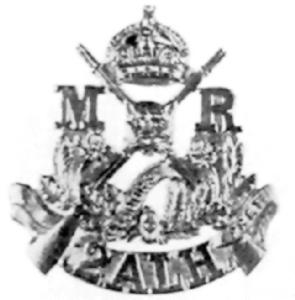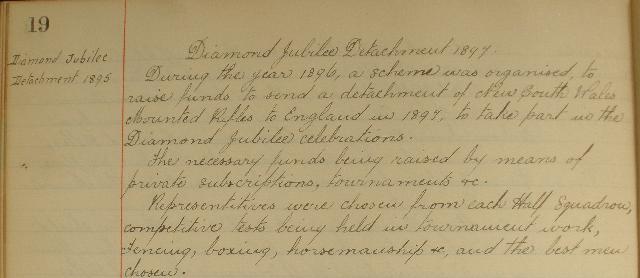Topic: Militia - LHN - 2/9/6
NSWMR
New South Wales Mounted Rifles
History, Part 8, 1897
New South Wales Mounted Rifles [1888 - 1903]
2nd (New South Wales Mounted Rifles) Australian Light Horse [1903 - 1912]
9th (New South Wales Mounted Rifles) Australian Light Horse [1912 - 1918]
6th (New South Wales Mounted Rifles) Australian Light Horse [1918 - 1941]
6th (New South Wales Mounted Rifles) Motor Regiment [1941 - 1943]
6th Australian Armoured Car Regiment [1941 - 1943]
6th (New South Wales Mounted Rifles) Motor Regiment [1948 - 1949]
6th New South Wales Mounted Rifles [1949 - 1958]
Royal New South Wales Regiment [1958 - 1960]

Toujours pret - Always Ready
Allied with: King Edward's Horse (The King's Overseas Dominions Regiment).
The following is the eighth extract from a manuscript written by an anonymous author. The hand written manuscript outlines the history of the 2nd ALHR NSW Mounted Rifles from commencement in 1888, until 5 April 1899, when history ceases. From the internal evidence of the manuscript, it appears to have been composed sometime from July 1903 to 1904.

The eighth extract from the manuscript.
Diamond Jubilee Detachment, 1897
During the year 1896, a scheme was organised to raise funds to send a detachment of New South Wales Mounted Rifles to England in 1897, to take part in the Diamond Jubilee celebrations
The necessary funds being raised by means of private subscriptions, tournaments etc.
Representatives were chosen from each Half Squadron, competitive tests being held in tournament work, fencing, boxing, horsemanship etc, and the best men chosen.
On Friday 15th January 1897, the Detachment assembled at Camden for a month's training, prior to embarkation. A specially selected lot of horses were also taken into camp, which were to accompany the Detachment, for use in tournament work etc. while in England.
On Friday 12th February 1897, the Detachment proceeded by Route March from Camden to Sydney, arriving at the agricultural Grounds, Moore Park, the following afternoon, where they were quartered until the day of embarkation.
On Wednesday 17th February 1897, the Detachment embarked with their horses on board the SS Gulf of Martaban, at Cowper Street Wharf, Woolloomooloo Bay.
The following comprised the Detachment:
Lieutenant Colonel HB Lassetter in command.
Major JW MacArther Onslow, Second in Command
Captain AJ Onslow Thompson
Lieutenant C Campbell
Lieutenant AJM Onslow
Lieutenant SS Ryrie
Warrant Officer R Holman, Staff
Staff Sergeant Major C Lydiard, No. 1 Bathurst ½ Squadron
Sergeant A McAllister, No. 4 Tenterfield ½ Squadron
Corporal D Fraser, No. 4 Inverell ½ Squadron
Lance Corporal H Munsie, No. 4 Inverell ½ Squadron
Lance Corporal W Armstrong, No. 1 Bathurst ½ Squadron
Lance Corporal H McIntosh, No. 1 Bathurst ½ Squadron
Shoeing Smith H Cady, No. 1 Molong ½ Squadron
Private D Ball, No. 1 Molong ½ Squadron
Private P Bridges, No. 1 Molong ½ Squadron
Private W Garlic, No. 1 Molong ½ Squadron
Private E Muntz, No. 1 Molong ½ Squadron
Private R Bartow, No. 1 Molong ½ Squadron
Private W Barham, No. 1 Bathurst ½ Squadron
Private H Cashman, No. 1 Bathurst ½ Squadron
Private G Morgan, No. 1 Bathurst ½ Squadron
Private A Thompson, No. 1 Bathurst ½ Squadron
Private J Small, No. 2 Camden ½ Squadron
Private H Taplin, No. 2 Camden ½ Squadron
Private AE Vaughn, No. 2 Camden ½ Squadron
Private J Ferris, No. 2 Camden ½ Squadron
Private JM Hawkey, No. 2 Camden ½ Squadron
Private J Bollard, No. 2 Picton ½ Squadron
Private EJ Fairley, No. 2 Picton ½ Squadron
Private C Vasshini, No. 2 Picton ½ Squadron
Private E Tarlinton, No. 3 Bega ½ Squadron
Private V Tarlinton, No. 3 Bega ½ Squadron
Private W Handscombe, No. 3 Bega ½ Squadron
Private H Perry, No. 3 Bega ½ Squadron
Private G Gribble, No. 3 Queanbeyan ½ Squadron
Private A Campbell, No. 4 Tenterfield ½ Squadron
Private P Kelly, No. 4 Tenterfield ½ Squadron
Private J Finnerty, No. 4 Tenterfield ½ Squadron
Private J Musie, No. 4 Inverell ½ Squadron
Captain Scott, Veterinary Surgeon, also accompanied the detachment.
On Thursday 22nd April 1897, the Detachment arrived at Albert Dock, London after a 64 days voyage.
Speaking of the NSW MR Detachment, the London Daily Mail of 22nd April 1897 says:
"The team of NSW Mounted Rifles, which is expected to disembark from the SS Gulf of Martaban at the Albert Dock this morning, will be the first body of colonial troops to arrive in connection with the forthcoming Jubilee Celebrations. It must not be supposed, however, that Colonel Lassetter and those under his command have come to the old country solely for the purpose of making a picturesque figure in the processions of June 22nd. Their presence in England at this particular period is opportune, because after the more serious work of the tournaments at London and Dublin, and the training that will be undergone at Hounslow with the Scots Greys, the team will be at liberty to join the New South Wales Cavalrymen in worthily representing their colony at the June festivities.
Officers and men are, of course, loyalists from plume to spur, and they look forward with the keenest gratification to the fact that they will play a part in the demonstration of honour to Her Majesty the Queen. But they also remember that there is a sterner duty to be done in England, and in preparation for it the last eighteen months have been passed. When these lads ride into the arena at Islington the English people will see a type of soldier peculiarly characteristic of the country from which they come.
They are picked men, all of them having been selected from each of the eight companies forming the Regiment. As a type they are the swarthy, lean and lithe warrior, with bone and muscle so hard that you couldn't drive a nail into any part of them. They ride like centaurs, for their saddle has been their cradle, and the horse that could throw one of them has not yet been foaled. As a rule the mounts are much lighter than those of the English Regiments, but they are all thoroughbred stock, and have been picked for the work with the utmost care.
The Regiment of Mounted Rifles ("Major General Hutton's Pets" as some of the men of the other branches of the service used to call them) is recruited from all sorts and conditions of men who dwell in the country, and have a soul for the work. There are boundary riders, stockmen, squatters, storemen, doctors, solicitors, and men of a hundred other callings. That they love the game is shown by their willingness to pay for it, as a remarkable instance of which it may be mentioned that of the £5,000 required for their present trip, £4,500 was subscribed by the Regiment itself, the balance coming from the Government. In most cases the men have given up their employments for the ambassadorial salary of one shilling and nine pence per day, which they will receive during their term of duty, and in many instances, men rode forty and fifty miles a day to attend drill, in the hope of getting into the picked team for England.
What wonder, then, that the Officers are proud of their men, and that Sergeant Major Holman ( as smart a non-com as ever wore a spur) is hopeful of success in the tournaments."
The following day, 22nd April, the Detachment with their 39 horses (three having been lost during the voyage) disembarked, and proceeded by rail to Hounslow, where they were quartered with the 2nd Royal Dragoons "Scots Greys".
A London daily paper, The Morning, speaking of the troops the following morning says:
Though the sun was shining brightly, the air was raw and keen yesterday morning when the disembarkation of the Detachment of New South Wales Mounted Rifles commenced at 8 o'clock at No. 8 Shed of the Royal Albert Dock, from the steamer Gulf of Martaban, and a considerable crowd of people were interested spectators of what was taking place. The horses were slung off the ship in boxes, and those who anticipated they would be superlatively frisky on touching earth was disappointed, for the animals seemed thoroughly done up after their long confinement. Some little difficulty was experienced in getting them into the trucks, in which they were conveyed to Hounslow, hence the process of disembarkation was slow, and it was nearly 1 o'clock pm before everything connected with the corps had been landed and was on board the train. Before leaving the dock, Colonel Lassetter received a telegram from Sir Saul Samuel, the Agent General for New South Wales, expressing regret that he was unable to be present. Cheers were raised as the "Special" started at half past one for Hounslow, to reach which a large portion of London was traversed, the route being via Canning Town, Tottenham, Addison Road and Clapham Junction. A few minutes before 3 o'clock, the train steamed into Hounslow Station. The approaches to the station were crowded with people, who had patiently waited since 11 o'clock, the hour it was stated the troops would arrive. In front of the building was the full band of the Scots Greys and the composite band of the Middlesex Regiment and the Royal Artillery, the bandsmen had also been in attendance for four hours. The horses, when taken out of the trucks, appeared even weaker than when first landed. This may partly be accounted for by the fact they were unshod, their shoes having been taken off in Sydney previous to starting. On the platform awaiting the troops, was Captain Miller, the Adjutant of the Royal Scots Greys, who extended a cordial welcome to the visitors.
Outside the station the men formed up, and particularly smart and soldierly they looked in their marching kit. This may be described as consisting of the "Terai" hat, with the cock feathers plume, brown tunics, pants, ammunition boots and gaiters, brown belts and bandolier. They carried Martini-Henry rifles and bayonets. Headed by the bands, a move was made for the barracks, amid the cheers of the assembled people. The horses, with halters, were led by men of the Scots Greys, who took charge of them at the station. The streets through which the soldiers passed were lined with cheering inhabitants, of the heartiness of whose welcome there could be no question. The following telegram was here received from Lord Carrington, on e of the most popular Governors New South Wales has ever had. It was addressed to Colonel Lassetter, and was as follows:
"Welcome and congratulations to Mounted Infantry on arrival, hope to see them on return to London. Lord and Lady Carrington, Gwydir Castle, North Wales."
When the barracks were reached, the scene was a stirring on. The Scots Greys and Depot Troops, as well as several hundred of the recruits of the Militia Battalions of the Middlesex and London Fusilier Regiments were gathered around the gates, and as the colonials entered the lively strains of the march the band was playing, were lost for the moment in deafening cheers of welcome. The Sergeants of the Scots Greys had prepared an elaborate dinner in their mess, and to this the whole of the NCOs and men of the troop were invited, while the Officers were entertained at luncheon by their colleagues of the Greys. The Officers and NCOs of the Mounted Rifles have been made members of the Officers and Sergeants messes of the Scots Greys respectively.
The New South Wales troops will be accommodated in the rooms usually occupied by the members of the band of the Scots Greys.
At "Retreat" last evening, three men of the troop mounted stable picket with the Scots Greys, and this may be taken as an earnest of the thoroughness with which all the Regimental duties will be shared by the colonials and the Greys.
On Wednesday 19th May 1897, Corporal J Apps (of Bathurst ½ Company) and Trumpeter V Daly (of Molong ½ Company), arrived with a draft of 6 horses for the Detachment, sent over by Mr Dangar, to replace those lost on the voyage.
During the period the Detachment was quartered at Hounslow, the time was taken up in practicing for the forthcoming Royal Military Tournaments at Islington and Dublin.
From 27th May to 10th June 1897, the Detachment was quartered at the Royal Agricultural Hall, Islington, where thy took part in the Royal Military Tournament, winning almost every competition that was competed for. A Bushranging Display was also given by the Detachment twice a day, during the whole ten days of the tournament for which the Imperial Authorities allowed £500 towards defraying the expenses of the Detachment, this display was also repeated at the tournament in Dublin the following week.
The Detachment took part in the Royal Military Tournament at Dublin from 12th to 18th June, where they were also successful in securing a fair percentage of the prizes.
On their return from Dublin, the Detachment took part in the Jubilee Celebrations, the Review of Colonial Troops by Lord Wolseley; and witness the Naval Review at Portsmouth.
On the 29th June 1897 the Detachment marched from Hounslow to Aldershot, where they took up quarters with the 6th Dragoon Guards "Carabineers" in the West Cavalry Barracks. During the period the Detachment was quartered at Aldershot, they took part in the Autumn Manoeuvres; also the Nation Rifle Association at Bisley, and competed in a Lloyd Lindsay competition at the meeting.
Speaking of the competition, the following the Daily Mail says:
Visitors to Bisley on the last day who watched the Lloyd Lindsay competition, could not help admiring the horsemanship displayed by Colonel Lassetter's Riflemen from New South Wales, and although they did not succeed in getting nearer the top of the list than third, there was absolutely no comparison between them and the Yeomanry. The Australians sat and rode with the knowledge and judgment of born horsemen, and if points had been given to them for style, equal to their merit, they would have been far ahead of the other competitors.
They were severely handicapped, however, in their weapons, as until three days before the event none of the team had ever used a Lee-Metford rifle. The opinions of the public was evident when the colonials came up to take their awards from the Duchess of York, and the hope expressed by the Duke that they will return next year was warmly endorsed by everyone present, for never in the annals of the NRA has a meeting been so full of interest as it has this year and that thanks mainly to these colonial soldiers of the Queen, whose manly bearing and soldier like qualities have assured the most sceptical that as long as our dependencies produce such men, Britain stands in no danger of any foe, however powerful."
On 6th August 1897, the Detachment left Aldershot having finally completed their course of training; the horses were taken to Tattersalls' Bazaar, London, where they were sold on the 9th August for an average of forty two guineas each, the highest price obtained being one hundred and ten guineas.
On the following day, 10th August, the whole of the Detachment was allowed general leave until the 2nd September, the Headquarters being at St George's Barracks, Trafalgar Square.
On the 3rd September 1897, the Detachment embarked for New South Wales, on board the Royal Mail Steamer, Aruba, at Tilbury Dock.
On Friday 15th October 1897, the Detachment arrived at Sydney, disembarked and marched to Victoria Barracks where they were inspected by General French, GOC New South Wales Military Forces.
The following day, 16th October, Major JW Onslow addressed the Officers and men at Chancery Square, after which the Detachment was finally disbanded and the men returned to their respective headquarters.
During the homeward voyage, one of the Detachment, Private W Handscombe, died and was buried at sea.
Major Menzies in Command, 17 February 1897
During the absence of Lieutenant Colonel Lassetter and Major JW Onslow with the Detachment in England, Captain and Honorary Major AS Menzies, assumed temporary command of the Mounted Rifle Regiment.
Major JWM Onslow in Command, 20 October 1897
Major JW MacArthur Onslow having returned from England, assumed temporary command of the Mounted Rifles Regiment during the absence of Lieutenant Colonel Lassetter from 20th October 1897.
"Duff" Competition, 1897
On the 30th October 1897 the "Duff Challenge Cup" was again competed for on the Randwick Rifle Range. The competition was won this year by a section from No. 3 Bega Half Squadron of the Mounted Rifles commanded by .
Lieutenant Colonel Lassetter assumed command, 1 November 1897
Lieutenant Colonel Lassetter having returned from England on 1st November 1897, assumed command of the Regiment.
Previous: New South Wales Mounted Rifles, History, Part 7, 1896
Next: New South Wales Mounted Rifles, History, Part 9, 1898
Further Reading:
2nd/9th/6th Australian Light Horse
Militia Light Horse, New South Wales
Australian Militia Light Horse
Citation: New South Wales Mounted Rifles, History, Part 8, 1897



